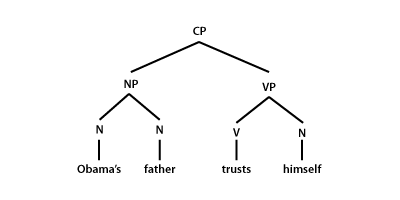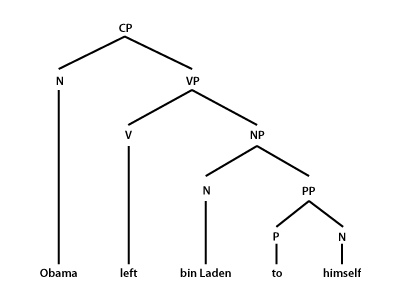“Obama Trusts Himself When All Men Doubt Him.”
 Or so a news headline runs.
Or so a news headline runs.
There may be doubts about Obama’s ability, but there is absolutely no doubt that both himself and him here refer to the same person, namely Obama. It is therefore bizarrely remarkable that we have to use two different words to denote the same concept. But on second thought, maybe they are not quite the same.
The words him and himself both belong to a group of words called anaphora because they refer to an entity which has been previous mentioned or is understood in the current context. (The word anaphora comes from a Greek root meaning “to carry again”, ana- “again” + -phore “carry”.) More specifically, linguists call him a pronoun and himself a reflexive pronoun. The distinction between a pronoun and a reflexive pronoun may seem trivial at first glance. We use a reflexive pronoun when the object refers to the same person or the same thing as the subject, and we use a normal pronoun otherwise.
To illustrate this, let us look at the following examples:
1. Obamai trusts himselfi.
2. Obamai trusts himj.
Using subscripts (indices) to denote reference, himself refers to the subject of the sentence, Obama, hence they are said to be co-indexed. In (2), however, since him is used, we know it cannot refer to the subject Obama, so it must refer to someone else – anyone but Obama.
The picture gets more complicated when we consider complex sentences:
3. Bin Ladeni knows Obamaj trusts himselfj.
4. Bin Ladeni knows Obamaj trusts himi/k.
In (3), himself can only co-index with Obama but not bin Laden, whereas in (4) him can refer to anyone else, including bin Laden, but not Obama.
At this stage, we can propose a hypothesis that a reflexive pronoun can only refer to the subject in the immediate clause. On the other hand, a pronoun can refer to anything but the subject of the immediate clause.
This hypothesis is useful and in fact correct to a large extent, but it still does not tell the whole story if we want to accomodate more factual data.
5. [Obamai‘s father]j trusts himselfj.
6. [Obamai‘s father]j trusts himi/k.
7. Obamai left bin Ladenj to himselfi/j.
(5) and (6) show that a reflexive can only co-index with the entire subject phrase, but not anything within the phrase. It is quite understandable, but (7) poses a greater problem to our hypothesis. It says a reflexive pronoun can refer to something other than the subject, and in the case of (7), it is the direct object.
C-Command
In order to generalize the grammatical patterns we have discussed, linguists have come up with a theoretical concept called c-command, short for “constituent command”.

Syntactic tree
In order to understand c-command, we must try to visualize sentences as hierarchical syntactic trees. In a syntactic tree, a constituent α c-commands another constituent β if β is a sister node of α or a descendant of that node.
Therefore, in the tree shown on the right, B c-commands C, D, E, F and G; D c-commands E, F and G; and F c-commands G. We can also say C c-commands B, E c-commands D, or G c-commands F too. However, A, having no sister node, does not c-command anything.
Once we understand the c-command relationship, we can move on the analyze the sentences we have discussed. The syntactic structure of (3) is shown below.

3. Bin Laden knows Obama trusts himself.
Linguists say a reflexive pronoun must be c-commanded by its antecedant (i.e. its reference) in its local domain. A domain basically means a simple clause, represented in the tree by the label CP. From the tree, we can see that both bin Laden and Obama can c-command the N-node holding himself. However, only Obama is within the local domain (represented by the pink box) of himself, so only Obama is a possible antecedant, and bin Laden is not.
Pronouns like him, on the other hand, must be c-commanded by an antecedant NOT in the local domain. This explains why him in (4) cannot co-index with Obama.
Let us now take a look at the structure of example (5).

5. Obama's father trusts himself.
In this case, the N-node Obama is inside an NP-node (noun phrase). It cannot c-command the N-node of himself. Therefore, himself does not refer to Obama here. Instead, what c-commands himself is the entire NP-node Obama’s father.
The syntactic analysis of predicates having both a direct object and an indirect object, such as (7) and (8), is much more complicated and involves many theoretical issues. A simplified tree of example (7) would look like this:

7. Obama left bin Laden to himself.
In a nutshell, both Obama and bin Laden can c-command himself. As a result, it is possible for himself to refer to either the subject or the direct object. Of course, in this case, if himself co-indexes with Obama, the sentence may sound somewhat strange. It would mean “Obama kept bin Laden for himself”.
But that could be true, who knows?

